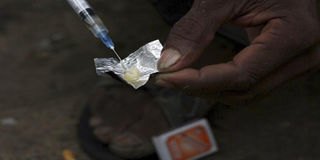How can we rescue our youth from drugs

A user users a syringe to suck up a mixture of heroin and water prepared on a foil wrap.
What you need to know:
Narcotics do not only cause sicknesses and loss of self management, but also expose users to HIV infection as more than one person share a syringe to inject them.
Dar es Salaam. Despite the dreadful impact illicit drugs have on societies, the public remains silent as narcotics continue to destroy the youth.
Drug abuse is not only a Tanzanian problem; it is a global catastrophe that requires quick intervention lest it continues destroying the lives of our youth.
Narcotics do not only cause sicknesses and loss of self management, but also expose users to HIV infection as more than one person share a syringe to inject them.
They also destroy the youth’s sense of direction, leading them to abandon either school or work and become a burden not only to their families, but also to the entire society.
Drug abuse prevalence is increasing in Tanzania and around the world, according to the 2015 World Drug Report of the UN Office on Drugs and Crime (UNODC).
It is estimated that a total of 246 million people - slightly over 5 per cent of those aged from 15 to 64 years worldwide - used an illicit drug in 2013.
Some 27 million people are chronic consumers and almost half of them are people who inject drugs (PWID). An estimated 1.65 million of the PWID were living with HIV in 2013.
Men are three times more likely than women to use cannabis, cocaine and amphetamines, while women are more likely to misuse prescription opioid and tranquillisers.
According to the 2016 International Narcotics Control Strategy Report, Tanzania is a significant transit country for illicit drugs, most notably heroin originating from Afghanistan and cocaine from South America, with a growing domestic user population.
Tanzanian drug trafficking organisations and courier networks operate globally with cells throughout Africa, Asia, Australia, Europe, North America, and South America.
These drugs trafficking organisations play a prominent role in the Southwest Asian heroin trade. Tanzania also produces cannabis both for domestic consumption and international distribution.
There were several successes in targeting illicit drug trafficking organisations operating in and through Tanzania in 2015, including two convictions against significant traffickers.
In November, a Tanzania court convicted Chukwudi Okechukwu, who was arrested in 2011 for smuggling cocaine with a street value of approximately $1.4 million. In September, Fred William Chonde was convicted of trafficking 180 kilogrammes of heroin in 2011.
In the backdrop of these incidents, a Centre for Life and Hope, Sober House Non Profit Life and Rehabilitation Organisation based in Bagamoyo sought a solution for preventing youth from losing sense of direction through drug abuse.
The chairman of the organisation, Mr Banji Al Karim, said the centre aimed at helping the young drug addicts to return to their normal life.
“Our rehabilitation centre not only helps drug addicts, but also alcoholics to stop the addiction and dependence on the narcotics,” he said.
He said the centre had been offering rehabilitation services to people in need of stopping the addiction countrywide.
Ever since the centre was established, they have offered services to about 100 youth who have done away with addiction and returned to normal life.
The centre, which was established in September last year with only five youths, including drug addicts and alcoholics, boasts reaching out to 100 other addicts so far cured.
“At the moment we’ve about 40 youths undergoing treatment,” he said.
The centre goes out to look for the youth whose relatives have abandoned them only to find them living in difficult conditions and either partially or wholly affected by drugs.
In some cases, family members send the ill-fated youth to the centre where they abandon them, he says, adding:
“Relatives bringing in their drug addicted folks are required to contribute a certain percentage of the treatment fee, but they often never come back.”
As a result, he said, the centre was in serious shortage of funds it needs so that it can continue administering medication to the youth, paying rent, providing the youth with food and paying salaries to those taking care of them.
The centre needs its own building and at least one vehicle for picking patients if it was to operate smoothly, he said, adding: “We also need computers for keeping the patients busy with development activities instead of drugs,” he said.
Mr Abdul Ayub, a former employee of a parastatal (name withheld), said he had been a law abiding citizen and hard worker before his peers lured him into drug abuse and became addicted. He ended up losing his sense of life and was sacked.
“l was in bad shape when I was sent to the centre, thanks to their medication, for I am now back to my sense and can go on with my working life although I haven’t landed another job yet,” he said.
One of the employees at the centre, Mr Hassan Lukumbi, says the majority of drug addicts they receive are young individuals aged between 25 and 35.
“We received eight youth, seven male and a female, last month alone,” he recalled, as he urged Tanzanians to consider protecting the youth against the influence of drugs.
Meanwhile, the Bagamoyo district commissioner, Mr Masjid Mwanga, vowed that his office would work shoulder to shoulder with the centre to ensure the war against drug abuse is vigorously fought and won across the country.
The district, he said, was devising deliberate strategies that would see supply of narcotic drugs curtailed once for all, he said.




